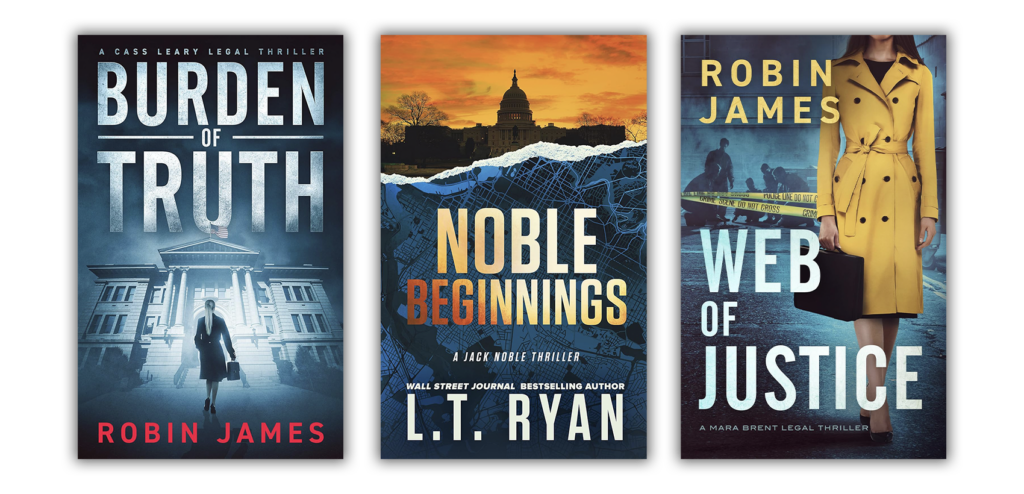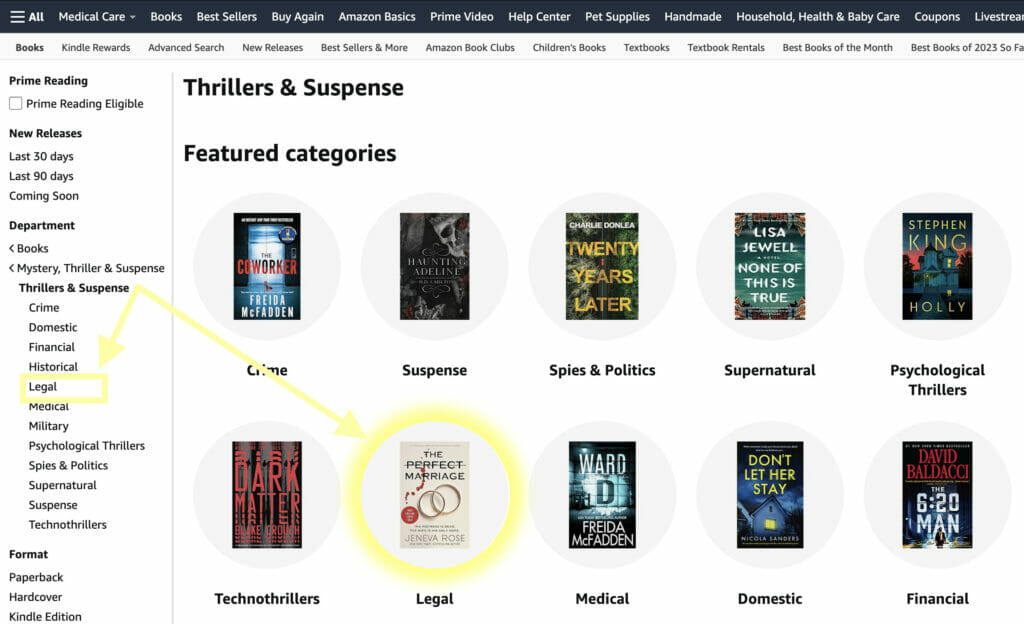Thrillers of any kind are the best books to keep readers turning a page, and there’s one that’s more popular than many others. Legal thrillers take the cake. But what is a legal thriller? And how do you know you’re writing one?
The truth is that if a reader likes one legal thriller, they’ll seek them out time and time again. The more familiar they are with this subgenre, the more they’ll want an author to hit all the right marks to fulfill their expectations. And we all know how important fulfilling genre expectations is.
This isn’t about the reader “knowing what’s coming” and more about how certain genres hit certain story arcs and if the author strays too far (while still calling it a certain genre), the reader can be upset.
So what is a legal thriller, and how can you start one for yourself?
- What is a legal thriller
- Examples of famous legal thrillers
- Start writing a legal thriller
- Determine the subset of “legal”
- Study the law
- Understand the genre expectations
- Craft a capable main character
- Come up with an interesting conflict
- Plot the story
What is a Legal Thriller?
A legal thriller book is a subgenre of thriller with a story that revolves around the tension and suspense of a drama centering around a courtroom and legal system, including the home-lives of the characters.
While it’s about the legal system, it’s also about the intricacies of working in a legal system that has so much drama while also living a real life, and the conflicts that can arise from the two worlds coming together. Understandably, depending on the severity of the crime and legality in question, these stories can become dangerous and therefore, full of tension and the kind of suspense that lends itself to the thriller genre.

Examples of Famous Legal Thrillers
We read to learn! All writers, no matter which genre you want to write in, but especially if you find yourself wondering what is a legal thriller, should read as much as you can (more on why below).
To start, here are some of the most famous legal thrillers.
1. To Kill a Mockingbird by Harper Lee
This classic novel tells the story of Atticus Finch, a lawyer in the racially charged American South who defends a black man accused of raping a white woman. The book explores themes of racism, justice, and morality. Because the story takes place during a particular case, we get to see the inner-workings of a system that just might be broken, and how the uncertainty adds to the suspense.
2. Presumed Innocent by Scott Turow
This novel follows the story of Rusty Sabich, a prosecutor who finds himself accused of murdering his colleague and lover. The book is known for its intricate plot and exploration of legal ethics, both of which only add to the suspense of what will happen next.
3. The Firm by John Grisham
Grisham is one of the most well-known authors of legal thrillers, and The Firm is one of his most famous works. Check out this article for a complete list of Grisham’s books. The Firm revolves around a young attorney who joins a prestigious law firm only to discover dark secrets and illegal activities. It’s a powerful look into the justice system, and how misplaced trust can lead to certain conclusions.
4. A Time to Kill by John Grisham
Another Grisham classic (just read his books in general), this book centers around a racially charged trial in Mississippi where a black man is on trial for killing the two white men who raped his daughter. The novel delves into themes of race, justice, and revenge.
5. The Lincoln Lawyer by Michael Connelly
This novel introduces Mickey Haller, a defense attorney who conducts his business from the back seat of his Lincoln Town Car. The story follows Haller as he defends a wealthy client accused of assault. This story has been adapted a few times now, for a movie and a TV show due to the fan base it’s amassed.
If you want to learn how to write a likable character and then take them on a suspenseful ride, this is the book for you.
How to Get Started Writing a Legal Thriller
What that we’ve answered the question of “what is a legal thriller,” it’s time to dive into writing one for yourself. While most of these steps are similar to writing other books, even supernatural thriller subgenre or alternate history fiction, there are some steps necessary for only legal thrillers.
1. Determine the subset of “legal”
It’s a broad subgenre. “Legal” doesn’t always represent a courtroom only. You’ll want to figure out which part of the legal system you want to focus on and write about. Keep in mind that readers of legal thriller have been reading courtroom specific books for a while and could be seeking a fresh take on it.
How can you still write legal thriller but make it more unique?
Here are other jobs in the legal system you could explore:
- Cop
- Journalist
- Court reporter
- Judge
- Law Professor
- Mediator
- Coroner
Basically, any job that has to be gone through in order to arrest or convict someone is fair game to use in a legal thriller.
A good example of using a legal thriller but tweaking the main characters is with How to Get Away With Murder. The show centers on a criminal law professor and a law student, but more on choosing the right character for your legal thriller below.
2. Study up on law if you’re unaware
The best legal thrillers are written by those who have immense knowledge of the field. Take John Grisham, for example. He practiced law before writing some of the most famous legal thrillers out there.
You have to write a convincing story if you want to write legal thrillers. If it’s not realistic, you’ll lose suspension of disbelief and that means your story won’t have the tension and suspense necessary to keep a reader engaged.
This might look like watching Youtube videos or even reading up on law practices to understand how the system actually works and not how you think it works (if you’re someone who’s never worked in it before).
3. Understand the genre expectations
The best thing to do here is to just read a lot of it. What seem to be the repeatable arcs the stories follow? What are some of the tropes you see time and time again?
This isn’t so you copy other authors. It’s just to understand what avid readers of this genre want in a legal thriller.
To read some more recent and popular ones, just go to the Amazon category and discover the bestselling ones.
Here are the steps to find the bestselling legal thrillers to study:
- Go to Amazon and choose “Books” from the dropdown menu next to the search bar. Hit “enter” and you’ll go to the Books homepage for Amazon.
- Scroll down until you find the genres on the left side
- Select “Mystery, Thriller & Suspense”
- Then choose “Thrillers & Suspense”
- From here, you’ll see the Thriller & Suspense book page, with choices of subgenres both in the side menu and on the main page. Hit “Legal”
- Here you’ll be able to browse “Top Rated” and “Bestsellers” categories. Hit the “See All” options to get a better list and start picking a few out!

4. Craft a capable main character
Legal thrillers tend to have highly capable, talented, and skilled main characters. This is where a lot of the tension comes from. This character isn’t helpless. In fact, they can solve a lot of problems, which is why the severity of other issues is all the more concerning.
All this really means is developing a character who is good at their job. Remember that this job doesn’t need to be “lawyer” in order to be a good legal thriller. In fact, creating a job that’s adjacent to a lawyer may make for a more interesting an compelling story.
5. Come up with an interesting conflict
Conflict is what drives your story forward. It’s the interesting part. When readers read the book description (back cover), what they’re looking for is the type of conflict they’ll be getting into. Take this book’s description, The Southern Killer, for an example:
“Desperate to know the truth about the past, Hennessy battles to prove Alicia is innocent. Fighting against corrupt cops, outlaw motorcycle gangs, and ruthless prisoners, the evidence leads Hennessy into the dangers of the criminal underworld.
Despite his full caseload, Hennessy agrees to defend a building construction manager against a charge of Grand Larceny. The further Hennessy works into the case, the more he finds that everything is connected.As the cases progress, Hennessy uncovers a secret about his murdered son that has remained hidden for twenty years.
But to reveal the truth, to take that risk, Joe Hennessy must battle the entire system…”
Right away, the reader knows that the conflict involves: a 20-year-old murder, an array of conflicts with cops, motorcycle gangs, and prisoners. We can also see that an additional conflict is the fact that this lawyer already has a full case load.
When it comes to the story’s conflict, thinking about how you can involve the character’s personal life is really important. It’s not just about their job. It has to tie into their lives so we can have the kind of character arc that makes for a good story.
6. Plot the story
The way this story is plotted is specific to legal thrillers. You’ll have to read and figure out what to include and at what points. Typically, though, a novel can be thought of like this:
- The introduction: This might look like an average day-in-the-life for your character. Are they working a case? Are they involved in the court system? Show us what their life is like now so we know what’s at stake when the inciting incident happens.
- The inciting incident: For legal thrillers, this would probably be taking on the case or becoming ensnared in the legal conflict at hand
- First Slap: This is our terminology for the first major fail. A big flop happens and it sets them back or they get into even more trouble than they were in before. Bigger conflict is unveiled.
- Second Slap: After the main character makes a sort of “comeback” after the first slap, they’re hit with the biggest set back of all. At this point, the main character has all but given up. They don’t see how they can succeed in their goal now.
- Climax: Here’s where the story’s conflict and character growth come together at once to solve the problem. That’s the tricky part. When the character is at an all-time low, they have to draw from somewhere else in order to persevere. This usually requires the main character growing in certain ways in order to see or acknowledge or take action toward the solution. The antagonist and protagonist come head to head in the climax, among other steps that need to happen.
- Resolution: The open loops are closed. Any other conflicts are wrapped up if this is a standalone. If it’s a series, the next conflict is opened or acknowledged so you have a hook to get readers to the next book.
At the end of the day, the plotting can take some time. Working the plot and character so they can both be realized during the climax is often the hardest part. But don’t give up! If you need some extra help, seeking a fiction coach is always a great step.
Knowing what is a legal thriller is important for writing the correct kind of book. It’s not a mystery! Take these tips and start writing your own.
